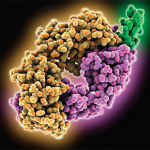
Dr. Gaffo
Dr. Gaffo did express some concerns. Because of the pragmatic nature of the study, a few imbalances occurred in the randomization assignments. In addition, “There may be some controversy because the 500 mg of rituximab dosing strategy they chose may not be representative of what everyone does,” he says. “Many centers use a 1,000 mg dose protocol.”
One of the messages for everyday practice is that maintenance strategies for rituximab continue to prove quite effective. They probably should be preferred over regimens that prescribe traditional agents, he says.
“The second important lesson is that basing maintenance strategies on monitoring ANCA and/or CD19+ B cells is a promising method to expose patients to less drug,” said Dr. Gaffo. “This in turn could decrease the cost of treatment while also keeping up effectiveness and keeping patients in remission.”
Kurt Ullman has been a freelance writer for more than 30 years and a contributing writer to The Rheumatologist for more than 10 years.
Does Rituximab Beat Azathioprine?
MAINRITSAN2 confirms rituximab is the best treatment to maintain AAV remission, says Dr. Charles.

Dr. Pagnoux
Christian Pagnoux, MD, MPH, MSc, a rheumatologist at Mount Sinai Hospital and associate professor at the University of Toronto in Canada, notes that an earlier study by the same group in 2014 showed rituximab was superior to conventional maintenance treatment with azathioprine at preventing relapses of patients with GPA or MPA, but rituximab does not have regulatory approval for maintenance in those rare diseases.2
For now, most patients are left with conventional maintenance treatments with azathioprine or methotrexate after remission, says Dr. Pagnoux, who was involved in the first, but not this second, MAINRITSAN trial. “Some [patients] have drug coverage plans that allow rituximab for maintenance, or they pay out of pocket to receive rituximab maintenance reinfusions.
“The good (and reassuring) news from MAINRITSAN2 is that those patients can be treated with rituximab 500 mg reinfusions based on their serial ANCA titers and CD19+ B cell counts, if thoroughly monitored and measured every three months,” Dr. Pagnoux says.
Catherine Kolonko is a medical writer based in Oregon.
References
- Charles P, Terrier B, Perrodeau É, et al. Comparison of individually tailored versus fixed-schedule rituximab regimen to maintain ANCA-associated vasculitis remission: Results of a multicentre, randomised controlled, phase III trial (MAINRITSAN2). Ann Rheum Dis. 2018 Aug;77(8):1143–1149.
- Pugnet G, Pagnoux C, Terrier B, et al. Rituximab versus azathioprine for ANCA-associated vasculitis maintenance therapy: Impact on global disability and health-related quality of life. Clin Exp Rheumatol. 2016 May–Jun;34(3 Suppl 97):S54–S59.

